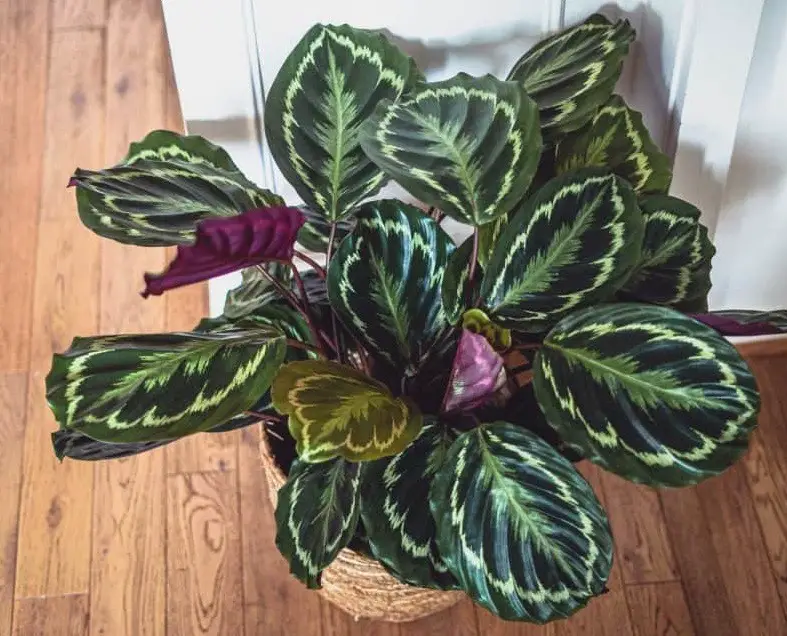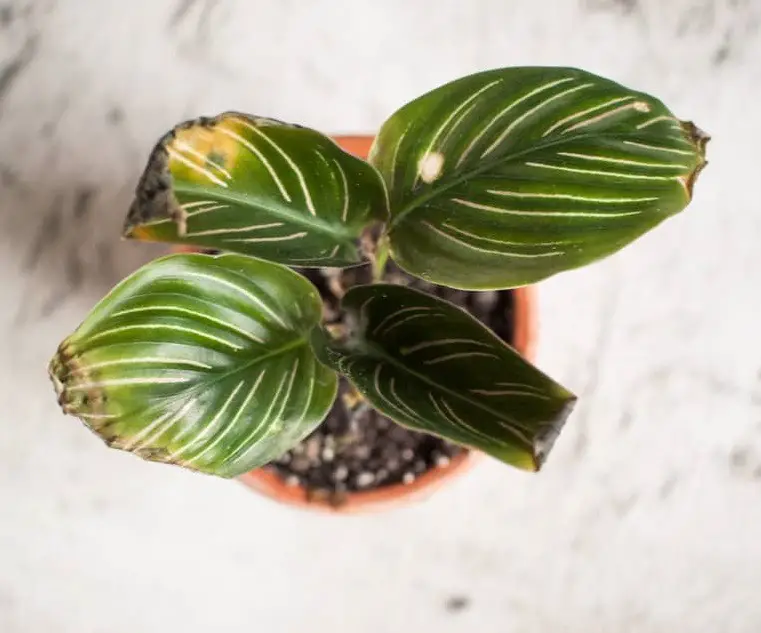I have been growing different types of calatheas for over a decade now. These houseplants are super easy to grow and maintain regardless of an individual experience. Calathea leaves turning brown is an indication of inappropriate care routines.
So, why are my calathea leaves turning brown? Under-watering and low humidity are the leading cause of brown calathea leaves. Other causes are over-fertilization, transplant stress, pest infestation, heat stress, and fungal infection.
Reviving the brown calathea leaves to green is impossible. I recommend trimming these brown foliages to keep the plant healthy. Keep reading to learn how to save a dying calathea plant by identifying the exact causes.
You May Also Like: How to Care for Hoya Curtisii

Reasons for Calathea Leaves Turning Brown
Low Humidity
Most calathea species prefer high humidity to stay happy and healthy. Every houseplant enthusiast needs to replicate this tropical condition at home.
Brown calathea leaves are indicators of dry air moisture around the plant. These plants have sensitive leaves prone to discoloration due to low humidity.
Use an electric humidifier to maintain indoor humidity above 50%. It will help avoid calathea leaves turning brown on the tips and edges.
Inconsistent Watering Routine
Calathea plants thrive in relatively moist potting soil. I recommend watering the houseplant weekly without making the potting medium soggy.
Poke the index finger in 2-3 inches of the topsoil to test the soil moisture content. Soak the potting soil if it’s dry to avoid calathea leaves turning brown.
The watering frequency depends on the environmental conditions and plant size. Calathea consumes more watering during spring and summer.
Reduce the watering frequency during late fall and winter. It is the dormancy phase, and most houseplants do not experience active growth.
Other signs of underwatered calathea are leaves drooping, curling, and crispy. Rehydrate the plant with distilled or rainwater to resolve these foliage issues.
Chlorine or Fluoride in Water
Calatheas receive high water quality in their native habitat. Tap water contains chlorine and fluoride minerals that are harsh on the leaves.
Excessive accumulation of these minerals on the plant foliages is the cause of the discoloration. Switch to distilled water or rainwater to resolve the problem.
Another excellent option is to let the tap water sits overnight before using it to allow these minerals to settle at the bottom of the container.
Direct Sunlight Exposure
Calatheas can tolerate low light for an extended period. But the plant will become leggy and experience stunted growth in the long run.
These houseplants thrive well in bright indirect sunlight. The low light intensity allows the houseplant to undertake its physiological activities well.
Brown leaves on a calathea plant are due to direct sunlight exposure. The high light intensity scorches the leaves and even forces the plant to droop.
I recommend keeping the plant near the window with sheer curtains. These curtains will help reduce the sunlight intensity and avoid burning the leaves.
Early morning or late evening direct sunlight will not harm your favorite plant. It is the best option for those growers with dark indoor spaces.
Transplant Shock
Calathea leaves turning brown are due to transplant and propagation. These tropical houseplants experience stress when transplanted into the new soil.
Sudden change in environment causes transplant shock. Stress disrupts the absorption of water and nutrients. The issue later results in leaves turning yellow and brown.
Always handle the houseplant with ultimate care when re-potting and propagating. Trim the damaged leaves and provide better calathea plant care.
Besides that, be patient with the plant and give it about four weeks to adjust to the new environment. Add sugar solution to the soil to speed up the recovery process.
Pest Infestation
Calathea plants are more vulnerable to pest infestation. High humidity and poor ventilation are the factors that facilitate insect infestations on calathea plants.
These sap-sucking creatures drain nutrients from the leaves and damage vital tissues. The brown spots on the leaves are indicators of pest infestations.
Mealybugs, scales, aphids, and spider mites are the leading insects that attack the houseplant. Inspect your houseplant foliages every week or during watering for these insects.
Be sure to isolate the plant to prevent the spreading of the pests. Use neem oil or insecticidal soap spray to eliminate the insects from this tropical houseplant.
Disease and Fungal Infection
Brown spots on calathea leaves are due to fungal infection. The condition occurs when the leaves remain wet for an extended period.
Using natural or commercial fungicide will inhibits fungal growth by killing the spores. Apply the fungal spray during cloudy evenings and not on a hot sunny day to avoid burning the leaves.
The process won’t treat the brown leaves but combat fungal infection from spreading. Trim the damaged leaves and provide ultimate care for the plant to recover.
Natural Aging Process
Calathea leaves turning yellow and brown are also due to the natural aging process. The foliage problem is inevitable despite providing ultimate care.
Cut the old foliages to conserve energy for the new growths. Pruning also helps to improve the plant’s appearance and control its growth.
Extreme Temperatures
Extreme temperature change is another cause of brown leaves in these tropical plants. These houseplants thrive in a warm and humid environment.
Calatheas cannot tolerate cold, drafts, or frost conditions. These plants become stressed when the temperature drops into the freezing points.
Raise the indoor temperature between 70oF and 85oF to resolve the brown leaves. Besides that, keep your plant away from cold and hot drafts.

Related Questions
Should I Cut off Brown Calathea Leaves?
Yes. It helps to redirect energy to the new growths and keep your houseplant healthy. Use a sterilized pruner when removing the brown leaves.
Where Should I Place My Calathea?
Place the calathea plant in a spot that receives bright indirect sunlight. Ensure the location does not experience cold or hot drafts.
Should I Mist My Calathea?
Yes. It helps to boost humidity around the houseplant. But I don’t recommend this method since keeping the leaves wet for an extended period will result in fungal infection.
Final Thoughts
Most calathea cultivars are beautiful, and keeping green foliages for an extended period can be challenging. It would be best to be more cautious and watchful when handling calatheas.
Calathea leaves turning brown are due to under-watering, transplant shock, over-fertilization, low humidity, pest infestation, and diseases.
Investigate your tropical plant to identify the exact cause before fixing it. Remember to replicate the tropical forest growing conditions at home.
